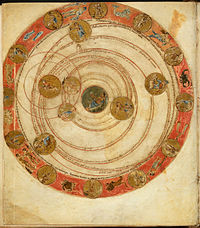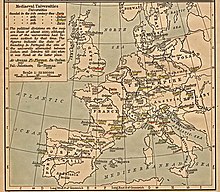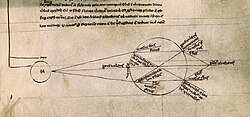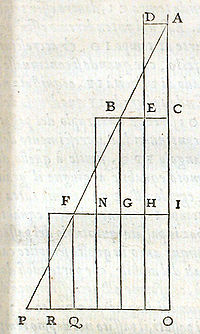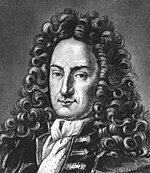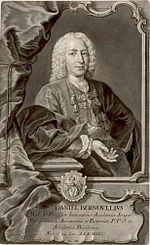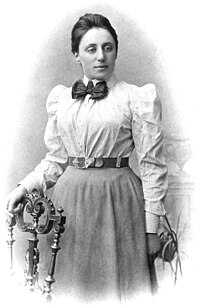Aristotle, by Francesco Hayez
Aristotelianism is a tradition of philosophy that takes its defining inspiration from the work of Aristotle.
This school of thought, in the modern sense of philosophy, covers
existence, ethics, mind and related subjects. In Aristotle's time,
philosophy included natural philosophy, which preceded the advent of modern science during the Scientific Revolution. The works of Aristotle were initially defended by the members of the Peripatetic school and later on by the Neoplatonists, who produced many commentaries on Aristotle's writings. In the Islamic Golden Age, Avicenna and Averroes translated the works of Aristotle into Arabic and under them, along with philosophers such as Al-Kindi and Al-Farabi, Aristotelianism became a major part of early Islamic philosophy.
Moses Maimonides adopted Aristotelianism from the Islamic scholars and based his famous Guide for the Perplexed
on it and that became the basis of Jewish scholastic philosophy.
Although some of Aristotle's logical works were known to western Europe,
it was not until the Latin translations of the 12th century that the works of Aristotle and his Arabic commentators became widely available. Scholars such as Albertus Magnus and Thomas Aquinas interpreted and systematized Aristotle's works in accordance with Christian theology.
After retreating under criticism from modern natural philosophers, the distinctively Aristotelian idea of teleology was transmitted through Wolff and Kant to Hegel, who applied it to history as a totality. Although this project was criticized by Trendelenburg and Brentano as non-Aristotelian, Hegel's influence is now often said to be responsible for an important Aristotelian influence upon Marx. Postmodernists, in contrast, reject Aristotelianism's claim to reveal important theoretical truths. In this, they follow Heidegger's critique of Aristotle as the greatest source of the entire tradition of Western philosophy.
Recent Aristotelian ethical and "practical" philosophy, such as that of Gadamer and McDowell,
is often premissed upon a rejection of Aristotelianism's traditional
metaphysical or theoretical philosophy. From this viewpoint, the early
modern tradition of political republicanism, which views the res publica, public sphere or state as constituted by its citizens' virtuous activity, can appear thoroughly Aristotelian.
The most famous contemporary Aristotelian philosopher is Alasdair MacIntyre. Especially famous for helping to revive virtue ethics in his book After Virtue,
MacIntyre revises Aristotelianism with the argument that the highest
temporal goods, which are internal to human beings, are actualized
through participation in social practices. He juxtaposes Aristotelianism
with the managerial institutions of capitalism and its state, and with
rival traditions — including the philosophies of Hume and Nietzsche —
that reject Aristotle's idea of essentially human goods and virtues and
instead legitimate capitalism. Therefore, on MacIntyre's account,
Aristotelianism is not identical with Western philosophy as a whole;
rather, it is "the best theory so far, [including] the best theory so
far about what makes a particular theory the best one." Politically and
socially, it has been characterized as a newly "revolutionary
Aristotelianism". This may be contrasted with the more conventional,
apolitical and effectively conservative uses of Aristotle by, for
example, Gadamer and McDowell. Other important contemporary Aristotelian
theorists include Fred D. Miller, Jr. in politics and Rosalind Hursthouse in ethics.
History
Ancient Greek
The original followers of Aristotle were the members of the Peripatetic school. The most prominent members of the school after Aristotle were Theophrastus and Strato of Lampsacus, who both continued Aristotle's researches. During the Roman era the school concentrated on preserving and defending his work. The most important figure in this regard was Alexander of Aphrodisias who commentated on Aristotle's writings. With the rise of Neoplatonism
in the 3rd century, Peripateticism as an independent philosophy came to
an end, but the Neoplatonists sought to incorporate Aristotle's
philosophy within their own system, and produced many commentaries on Aristotle.
Byzantine Empire
Byzantine Aristotelianism emerged in the Byzantine Empire
in the form of Aristotelian paraphrase: adaptations in which
Aristotle's text is rephrased, reorganized, and pruned, in order to make
it more easily understood. This genre was allegedly invented by Themistius in the mid-4th century, revived by Michael Psellos in the mid-11th century, and further developed by Sophonias in the late 13th to early 14th centuries.
Leo the Mathematician was appointed to the chair of philosophy at the Magnaura School in the mid-9th century to teach Aristotelian logic.
The 11th and 12th centuries saw the emergence of twelfth-century
Byzantine Aristotelianism. Before the 12th century, the whole Byzantine
output of Aristotelian commentaries was focused on logic.
However, the range of subjects covered by the Aristotelian commentaries
produced in the two decades after 1118 is much greater due to the
initiative of the princess Anna Comnena who commissioned a number of scholars to write commentaries on previously neglected works of Aristotle.
Islamic world
A medieval Arabic representation of Aristotle teaching a student.
In the Abbasid Empire, many foreign works were translated into Arabic, large libraries were constructed, and scholars were welcomed. Under the caliphs Harun al-Rashid and his son Al-Ma'mun, the House of Wisdom in Baghdad flourished. Christian scholar Hunayn ibn Ishaq
(809–873) was placed in charge of the translation work by the caliph.
In his lifetime, Ishaq translated 116 writings, including works by Plato
and Aristotle, into Syriac and Arabic.
With the founding of House of Wisdom, the entire corpus of Aristotelian works that had been preserved (excluding the Eudemian Ethics, Magna Moralia and Politics) became available, along with its Greek commentators; this corpus laid a uniform foundation for Islamic Aristotelianism.
Al-Kindi (801–873) was the first of the Muslim Peripatetic philosophers, and is known for his efforts to introduce Greek and Hellenistic philosophy to the Arab world.
He incorporated Aristotelian and Neoplatonist thought into an Islamic
philosophical framework. This was an important factor in the
introduction and popularization of Greek philosophy in the Muslim
intellectual world.
The philosopher Al-Farabi
(872–950) had great influence on science and philosophy for several
centuries, and in his time was widely thought second only to Aristotle
in knowledge (alluded to by his title of "the Second Teacher"). His
work, aimed at synthesis of philosophy and Sufism, paved the way for the work of Avicenna (980–1037). Avicenna was one of the main interpreters of Aristotle. The school of thought he founded became known as Avicennism, which was built on ingredients and conceptual building blocks that are largely Aristotelian and Neoplatonist.
At the western end of the Mediterranean Sea, during the reign of Al-Hakam II (961 to 976) in Córdoba, a massive translation effort was undertaken, and many books were translated into Arabic. Averroes (1126–1198), who spent much of his life in Cordoba and Seville,
was especially distinguished as a commentator of Aristotle. He often
wrote two or three different commentaries on the same work, and some 38
commentaries by Averroes on the works of Aristotle have been identified. Although his writings had only marginal impact in Islamic countries, his works would eventually have a huge impact in the Latin West, and would lead to the school of thought known as Averroism.
Western Europe
Although some knowledge of Aristotle seems to have lingered on in the
ecclesiastical centres of western Europe after the fall of the Roman
empire, by the ninth century nearly all that was known of Aristotle
consisted of Boethius's commentaries on the Organon, and a few abridgments made by Latin authors of the declining empire, Isidore of Seville and Martianus Capella. From that time until the end of the eleventh century, little progress is apparent in Aristotelian knowledge.
The renaissance of the 12th century saw a major search by European scholars for new learning. James of Venice, who probably spent some years in Constantinople, translated Aristotle's Posterior Analytics from Greek into Latin in the mid-twelfth century, thus making the complete Aristotelian logical corpus, the Organon,
available in Latin for the first time. Scholars travelled to areas of
Europe that once had been under Muslim rule and still had substantial
Arabic-speaking populations. From central Spain, which had come under Christian rule in the eleventh century, scholars produced many of the Latin translations of the 12th century. The most productive of these translators was Gerard of Cremona, (c. 1114–1187), who translated 87 books, which included many of the works of Aristotle such as his Posterior Analytics, Physics, On the Heavens, On Generation and Corruption, and Meteorology. Michael Scot (c. 1175–1232) translated Averroes' commentaries on the scientific works of Aristotle.
Aristotle's physical writings began to be discussed openly, and
at a time when Aristotle's method was permeating all theology, these
treatises were sufficient to cause his prohibition for heterodoxy in the Condemnations of 1210–1277. In the first of these, in Paris
in 1210, it was stated that "neither the books of Aristotle on natural
philosophy or their commentaries are to be read at Paris in public or
secret, and this we forbid under penalty of excommunication."
However, despite further attempts to restrict the teaching of
Aristotle, by 1270 the ban on Aristotle's natural philosophy was
ineffective.
William of Moerbeke
(c. 1215–1286) undertook a complete translation of the works of
Aristotle or, for some portions, a revision of existing translations. He
was the first translator of the Politics
(c. 1260) from Greek into Latin. Many copies of Aristotle in Latin then
in circulation were assumed to have been influenced by Averroes, who
was suspected of being a source of philosophical and theological errors
found in the earlier translations of Aristotle. Such claims were without
merit, however, as the Alexandrian Aristotelianism of Averroes
followed "the strict study of the text of Aristotle, which was
introduced by Avicenna, [because] a large amount of traditional Neoplatonism was incorporated with the body of traditional Aristotelianism".
Albertus Magnus
(c. 1200–1280) was among the first medieval scholars to apply
Aristotle's philosophy to Christian thought. He produced paraphrases of
most of the works of Aristotle available to him.
He digested, interpreted and systematized the whole of Aristotle's
works, gleaned from the Latin translations and notes of the Arabian
commentators, in accordance with Church doctrine. His efforts resulted
in the formation of a Christian reception of Aristotle in the Western
Europe. Magnus did not repudiate Plato. In that, he belonged to the dominant tradition of philosophy that preceded him, namely the "concordist tradition", which sought to harmonize Aristotle with Plato through interpretation (see for example Porphyry's On Plato and Aristotle Being Adherents of the Same School). Magnus famously wrote:
"Scias quod non perficitur homo in philosophia nisi ex scientia duarum philosophiarum: Aristotelis et Platonis." (Metaphysics, I, tr. 5, c. 5)
(Know that a man is not perfected in philosophy if it weren't for the knowledge of the two philosophers, Aristotle and Plato)
Thomas Aquinas (1225–1274), the pupil of Albertus Magnus, wrote a dozen commentaries on the works of Aristotle.
Thomas was emphatically Aristotelian, he adopted Aristotle's analysis
of physical objects, his view of place, time and motion, his proof of
the prime mover, his cosmology, his account of sense perception and
intellectual knowledge, and even parts of his moral philosophy. The philosophical school that arose as a legacy of the work of Thomas Aquinas was known as Thomism, and was especially influential among the Dominicans, and later, the Jesuits.
Using Albert's and Thomas's commentaries, as well as Marsilius of Padua's Defensor pacis, 14th-century scholar Nicole Oresme translated Aristotle's moral works into French and wrote extensive comments on them.
Modern era
After retreating under criticism from modern natural philosophers, the distinctively Aristotelian idea of teleology was transmitted through Wolff and Kant to Hegel, who applied it to history as a totality. Although this project was criticized by Trendelenburg and Brentano as un-Aristotelian, Hegel's influence is now often said to be responsible for an important Aristotelian influence upon Marx. Postmodernists, in contrast, reject Aristotelianism's claim to reveal important theoretical truths. In this, they follow Heidegger's critique of Aristotle as the greatest source of the entire tradition of Western philosophy.
Contemporary Aristotelianism
Aristotelianism is understood by its proponents as critically developing Plato's theories. Recent Aristotelian ethical and 'practical' philosophy, such as that of Gadamer and McDowell, is often premised upon a rejection of Aristotelianism's traditional metaphysical or theoretical philosophy. From this viewpoint, the early modern tradition of political republicanism, which views the res publica, public sphere or state as constituted by its citizens' virtuous activity, can appear thoroughly Aristotelian.
The contemporary Aristotelian philosopher Alasdair MacIntyre is specially famous for helping to revive virtue ethics in his book After Virtue.
MacIntyre revises Aristotelianism with the argument that the highest
temporal goods, which are internal to human beings, are actualized
through participation in social practices. He opposes Aristotelianism to
the managerial institutions of capitalism and its state, and to rival
traditions—including the philosophies of Hume, Kant, Kierkegaard, and Nietzsche—that reject its idea of essentially human goods and virtues and instead legitimize capitalism.
Therefore, on MacIntyre's account, Aristotelianism is not identical
with Western philosophy as a whole; rather, it is "the best theory so
far, [including] the best theory so far about what makes a particular
theory the best one."
Politically and socially, it has been characterized as a newly
'revolutionary Aristotelianism'. This may be contrasted with the more
conventional, apolitical and effectively conservative uses of Aristotle
by, for example, Gadamer and McDowell. Other important contemporary Aristotelian theorists include Fred D. Miller, Jr. in politics and Rosalind Hursthouse in ethics.
In metaphysics, an Aristotelian realism about universals is defended by such philosophers as David Malet Armstrong and Stephen Mumford, and is applied to the philosophy of mathematics by James Franklin.
Criticism
Bertrand Russell criticizes Aristotle's logic on the following points:
- The Aristotelian system allows formal defects leading to "bad metaphysics". For example, the following syllogism is permitted: "All golden mountains are mountains, all golden mountains are golden, therefore some mountains are golden", which insinuates the existence of at least one golden mountain. Furthermore, according to Russell, a predicate of a predicate can be a predicate of the original subject, which blurs the distinction between names and predicates with disastrous consequences; for example, a class with only one member is erroneously identified with that one member, making impossible to have a correct theory of the number one.
- The syllogism is overvalued in comparison to other forms of deduction. For example, syllogisms are not employed in mathematics since they are less convenient.
In addition, Russell ends his review of the Aristotelian logic with these words:
I conclude that the Aristotelian doctrines with which we have been concerned in this chapter are wholly false, with the exception of the formal theory of the syllogism, which is unimportant. Any person in the present day who wishes to learn logic will be wasting his time if he reads Aristotle or any of his disciples. Nonetheless, Aristotle's logical writings show great ability, and would have been useful to mankind if they had appeared at a time when intellectual originality was still active. Unfortunately, they appeared at the very end of the creative period of Greek thought, and therefore came to be accepted as authoritative. By the time that logical originality revived, a reign of two thousand years had made Aristotle very difficult to dethrone. Throughout modern times, practically every advance in science, in logic, or in philosophy has had to be made in the teeth of the opposition from Aristotle's disciples.



